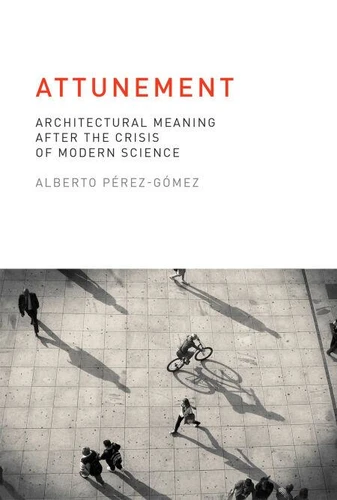Attunement. Architectural Meaning after the Crisis of Modern Science
Par :Formats :
Disponible dans votre compte client Decitre ou Furet du Nord dès validation de votre commande. Le format ePub protégé est :
- Compatible avec une lecture sur My Vivlio (smartphone, tablette, ordinateur)
- Compatible avec une lecture sur liseuses Vivlio
- Pour les liseuses autres que Vivlio, vous devez utiliser le logiciel Adobe Digital Edition. Non compatible avec la lecture sur les liseuses Kindle, Remarkable et Sony
- Non compatible avec un achat hors France métropolitaine
 , qui est-ce ?
, qui est-ce ?Notre partenaire de plateforme de lecture numérique où vous retrouverez l'ensemble de vos ebooks gratuitement
Pour en savoir plus sur nos ebooks, consultez notre aide en ligne ici
- Nombre de pages304
- FormatePub
- ISBN978-0-262-33333-7
- EAN9780262333337
- Date de parution22/07/2016
- Protection num.Adobe DRM
- Taille895 Ko
- Infos supplémentairesepub
- ÉditeurThe MIT Press
Résumé
How architecture can move beyond the contemporary enthusiasms for the technically sustainable and the formally dazzling to enhance our human values and capacities. Architecture remains in crisis, its social relevance lost between the two poles of formal innovation and technical sustainability. In Attunement, Alberto Pérez-Gómez calls for an architecture that can enhance our human values and capacities, an architecture that is connected-attuned-to its location and its inhabitants.
Architecture, Pérez-Gómez explains, operates as a communicative setting for societies; its beauty and its meaning lie in its connection to human health and self-understanding. Our physical places are of utmost importance for our well-being. Drawing on recent work in embodied cognition, Pérez-Gómez argues that the environment, including the built environment, matters not only as a material ecology but because it is nothing less than a constituent part of our consciousness.
To be fully self-aware, we need an external environment replete with meanings and emotions. Pérez-Gómez views architecture through the lens of mood and atmosphere, linking these ideas to the key German concept of Stimmung-attunement-and its roots in Pythagorean harmony and Vitruvian temperance or proportion. He considers the primacy of place over space; the linguistic aspect of architecture-the voices of architecture and the voice of the architect; architecture as a multisensory (not pictorial) experience, with Piranesi, Ledoux, and Hejduk as examples of metaphorical modeling; and how Stimmung might be put to work today to realize the contemporary possibilities of attunement.
Architecture, Pérez-Gómez explains, operates as a communicative setting for societies; its beauty and its meaning lie in its connection to human health and self-understanding. Our physical places are of utmost importance for our well-being. Drawing on recent work in embodied cognition, Pérez-Gómez argues that the environment, including the built environment, matters not only as a material ecology but because it is nothing less than a constituent part of our consciousness.
To be fully self-aware, we need an external environment replete with meanings and emotions. Pérez-Gómez views architecture through the lens of mood and atmosphere, linking these ideas to the key German concept of Stimmung-attunement-and its roots in Pythagorean harmony and Vitruvian temperance or proportion. He considers the primacy of place over space; the linguistic aspect of architecture-the voices of architecture and the voice of the architect; architecture as a multisensory (not pictorial) experience, with Piranesi, Ledoux, and Hejduk as examples of metaphorical modeling; and how Stimmung might be put to work today to realize the contemporary possibilities of attunement.
How architecture can move beyond the contemporary enthusiasms for the technically sustainable and the formally dazzling to enhance our human values and capacities. Architecture remains in crisis, its social relevance lost between the two poles of formal innovation and technical sustainability. In Attunement, Alberto Pérez-Gómez calls for an architecture that can enhance our human values and capacities, an architecture that is connected-attuned-to its location and its inhabitants.
Architecture, Pérez-Gómez explains, operates as a communicative setting for societies; its beauty and its meaning lie in its connection to human health and self-understanding. Our physical places are of utmost importance for our well-being. Drawing on recent work in embodied cognition, Pérez-Gómez argues that the environment, including the built environment, matters not only as a material ecology but because it is nothing less than a constituent part of our consciousness.
To be fully self-aware, we need an external environment replete with meanings and emotions. Pérez-Gómez views architecture through the lens of mood and atmosphere, linking these ideas to the key German concept of Stimmung-attunement-and its roots in Pythagorean harmony and Vitruvian temperance or proportion. He considers the primacy of place over space; the linguistic aspect of architecture-the voices of architecture and the voice of the architect; architecture as a multisensory (not pictorial) experience, with Piranesi, Ledoux, and Hejduk as examples of metaphorical modeling; and how Stimmung might be put to work today to realize the contemporary possibilities of attunement.
Architecture, Pérez-Gómez explains, operates as a communicative setting for societies; its beauty and its meaning lie in its connection to human health and self-understanding. Our physical places are of utmost importance for our well-being. Drawing on recent work in embodied cognition, Pérez-Gómez argues that the environment, including the built environment, matters not only as a material ecology but because it is nothing less than a constituent part of our consciousness.
To be fully self-aware, we need an external environment replete with meanings and emotions. Pérez-Gómez views architecture through the lens of mood and atmosphere, linking these ideas to the key German concept of Stimmung-attunement-and its roots in Pythagorean harmony and Vitruvian temperance or proportion. He considers the primacy of place over space; the linguistic aspect of architecture-the voices of architecture and the voice of the architect; architecture as a multisensory (not pictorial) experience, with Piranesi, Ledoux, and Hejduk as examples of metaphorical modeling; and how Stimmung might be put to work today to realize the contemporary possibilities of attunement.




